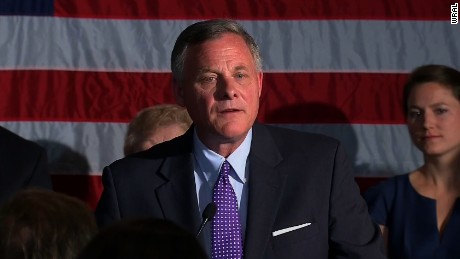Their bodies are buried in the cemetery, I’m sure of it. I’ve seen the obituaries.
But neither man is dead.
No one in Shishmaref dies, I’m told — not really.
It’s about 9 a.m. as I trudge through the snow, past the cemetery and to a neighboring house. The sky is frozen in pre-dawn twilight. The sun won’t rise for hours.
An elder answers the door and welcomes me into a living room that smells of sourdough and coffee. On the shelves, above a big-screen TV: dozens of figurines carved from walrus ivory, a tradition in this 560-person Inupiat village. How meta, I think. Walrus ivory carved back into the shape of a walrus, as if the animal were reincarnated from its own tusks.
Even walruses have a second life here, apparently.
The man offers me a seat and a coffee mug.
I’m here to ask him about Esau.
Yes, one of the men in the cemetery.
But also the 19-year-old born with the same name — the hoodie-wearing kid with the faint mustache. The one, among many, who’s trying to imagine another future for this village.
A future away from this island.
The blue house

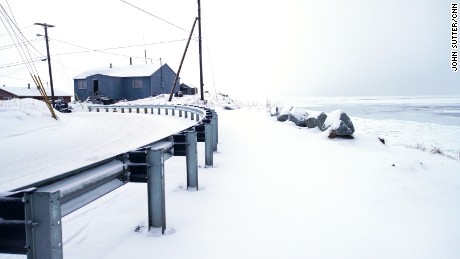
Shelton and Clara Kokeok live in a blue house at the edge of the village.
Everyone knows Shishmaref isn’t expected to last long.
Residents of this barrier island, located just south of the Arctic Circle, some 600 miles from Anchorage and only 100 miles from Russia, have been saying so for years.
To understand it, visit the tiny blue house at the edge of the land.
It’s the edge of the Earth, really. And it’s also the house where Norman grew up.
Norman, the second man in the cemetery.
Inside, an old woman sits in a wheelchair and an old man peers through the kitchen window at the Chukchi Sea. A cassette-radio buzzes with headlines from God-knows-where, but the man, Norman’s father, isn’t listening. Shelton Kokeok, a 72-year-old with palm-sized ears and a face that tragedy has worn into a grouper’s frown, is focused on the ocean. He scans it in a state of unease; creases etch his forehead. Shelton, who once was a light-hearted man, and whose kind eyes and infectious smile still hint at happier times, will be nervous until the water is frozen cement-hard. Today, in mid-December, it is the texture of a snow cone.
“It’s not really solid yet,” he tells me, forlorn. “Young ice, fresh ice, you know?”
These aren’t bored-old-man concerns.
The ice is disappearing.
And then there’s what happened to his son, Norman.
First, the ice.
Here, and across the Arctic, sea ice is forming later and thawing earlier.
That ice protects Shishmaref’s coast from erosion. Without it, punishing storms grab hunks of the land and pull it out to sea, shrinking and destabilizing the island.
Look at where the coast was in 2004 — and where it’s expected to be in 2053.
Shelton’s blue house is right on the edge of the receding coastline.
He worries it could fall in.
That happened to one of his neighbors.

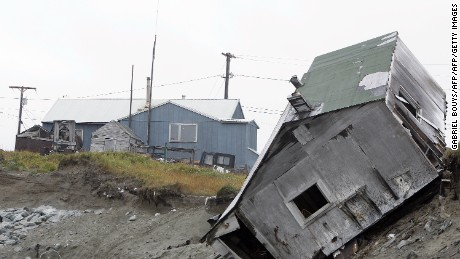
A house fell off the edge of the land in 2006. The Kokeok home is shown in the background.
As the world warms — thanks largely to the 1,200 metric tons of carbon dioxide we humans are pumping into the atmosphere each second — the ice is disappearing. The planet has warmed about 1 degree Celsius since the Industrial Revolution, when people started burning fossil fuels for heat and electricity, creating a blanket of heat-trapping gases in the atmosphere. But scientists say the Arctic, the far-north, is warming twice as fast as the rest of Earth.
“I miss that cold, cold weather,” says Hazel Fernandez. I meet her in a community hall; she’d rather be fishing on the ice but says it’s still too thin. “It’s too weird. It’s too warm.”
Outside, thermometers show temperatures in the mid-20s Fahrenheit, or about minus 4 Celsius. That’s freakishly warm for December, everyone tells me. I’m wearing two coats and ski pants, and residents of Shishmaref seem to find that hilarious. This isn’t cold, they say. Their sealskin hats and mittens, the fur-lined hooded parkas — those mostly stay at home.
Fernandez, in her early 60s, fondly remembers temperatures of 30- and 40-below Fahrenheit.
But mean air surface temperatures increased more than 2 degrees Celsius (3.6 degrees Fahrenheit) in the Arctic region between 1960 and 2011, according to the US National Snow & Ice Data Center. Arctic sea ice, measured since 1979, was at a monthly record low in January. And the September sea ice minimum is decreasing at a rate of 13.3% per decade.
The scientific consensus is that human pollution is driving these changes.
But it’s not the science or the charts that matter most to Shelton.
It’s not his blue house, either, perched precariously on the edge.
It’s his son, Norman.
It’s that day: June 2, 2007.
The day Norman fell through the ice and died.
Esau
The stories about Esau are easy to unearth.
Like people here, they never truly die.
“What was Esau like?” I ask the elder whose home is next to the white crosses and the cemetery, in the heart of this village of wooden homes and metal-sided buildings, a place where the winter landscape is an infinity of white, where there’s no running water or sewage service, where a shower costs $3.50 at the holiday rate, a 12-pack of Sprite $12.75. Most people prefer to live off the land, hunting seal, walrus and ptarmigan and fishing tomcod as their ancestors did.
The elder replies in a tone that is airy and patient, a voice measured through time.
Esau Weyiouanna was something of a renegade in Shishmaref, he tells me. He was an individual in a place that prides itself on community — an opinionated, outspoken man in a village where many would prefer to blend with the environment. In a photo that hangs on a friend’s wall today, Esau wears purple-and-green plaid and Napoleon-Dynamite bifocals, a knowing, understanding smile on his lips. His eyebrows are angled and inquisitive, like an owl’s.

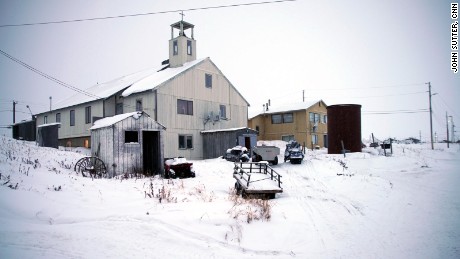
The local church in Shishmaref, Alaska.
Allow the elder to share one story.
Decades ago, the Christian church decided to ban some of the village’s Inupiat traditions, which had been passed from one generation to the next for centuries, if not longer. The church believed some of these traditions defied the will of God and were incompatible with its teachings. Dancing, in particular, was banned. Children of Shishmaref no longer could gather with drums made of stretched walrus stomach to move their bodies in the same artful patterns their parents, grandparents and great-grandparents always had, the elder tells me.
Esau was the rare man who could see both sides of this dispute, the kind of man who straddled worlds both modern and ancient. He served on the church board, the elder says. But he also loved the Inupiat cultural traditions — particularly the dance. So he took a stand. Esau danced boldly and in public, the elder tells me, to remind the community of the value of culture.
Today, the elder says, children are taught this dance in the local school.
This portal to the past remains open because of Esau.
Renegade, reborn
Decades later, and nearing death, Esau tried to ensure his story would continue.
He walked up to a pregnant woman and touched her stomach.
How am I doing in there? he asked.
It was a startling question, but up here in a world of ice, where no one really dies, or not for long, the meaning was clear to the mother. She knew Esau’s body soon would be laid to rest in the cemetery, and that he would be reincarnated as the child still growing inside her.
Esau Weyiouanna was declared dead on October 29, 1997.
On November 16, the woman’s child was born.
The family, following tradition, named him Esau.
Esau Sinnok.
A village renegade, reborn.
Norman


Shelton and Clara Kokeok, with a photo of their deceased son, Norman, who fell through the ice in 2007.
Elders say the ice should have been safe that day in 2007.
Norman had been on a hunting trip and was heading back into town in the early morning of late spring, when lower latitudes would still be shrouded in darkness but when this village sees nearly eternal sunshine, the tilt of the Earth making it possible to hunt through the night.
Village elders and family members tell me he was crossing a narrow part of the lagoon that separates Shishmaref and its barrier island from mainland Alaska. It may sound strange to drive a snowmobile across ice-covered water in June. But elders tell me the ice should have been frozen solid that time of year — that there was no indication Norman would be in danger.
Now, everyone is less trusting.
Some haven’t gone hunting on the ice since.
Norman’s death was particularly hard on his father, Shelton, who keeps a photo of the young man, wearing a buzz cut and Reno-911 mustache, on his coffee table, facing the door for all to see. Norman was a second-chance child, one he taught to hunt seal and follow traditions Inupiat people had followed here for at least four centuries, if not many more. Yet, from birth, the boy had an air of tragedy about him, even if no one in the family dared say so aloud.
It was in the name: Norman.
Norman was named after Shelton’s brother, who died in a plane crash.
The tragedy brought Shelton together with Clara, who was married to his brother.
In the wake of the accident, the two mourners decided to marry. Love was at the heart of it, to be sure, but Shelton also felt a sense of duty — duty to occupy the loving, supportive station his brother had left vacant in Clara’s life.
When one man leaves, another stands in his place.
‘Like an old soul’

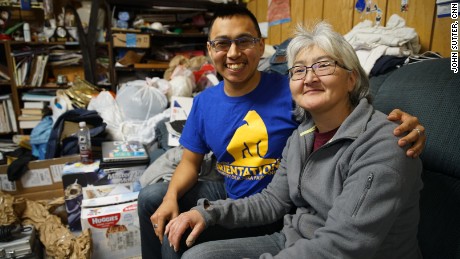
Esau Sinnok, 19, was adopted by his aunt, Bessi Sinnok.
The boy always seemed to possess knowledge from another life.
As a toddler, Esau Sinnok spouted off phrases in Inupiaq, the local language, even though no one had taught him to do so. Then, as a young boy, Esau was traveling with his birth mother across the empty landscape that surrounds Shishmaref. “That’s where I used to camp,” he told her. It was the very spot where his namesake, Esau Weyiouanna, used to stay.
It was as if the renegade elder were speaking through the boy.
A voice carried on the wind from one generation to the next.
People in the village treat it this way.
For many, it’s not just that young Esau reminds them of his namesake. It’s that Esau is the namesake elder, returned from the grave and walking among them. They sometimes call him “father” or “brother” or “cousin,” referencing their relationships with the elder who passed away.
Esau inherited the elder’s respected status, too. “He’s like an old soul,” says his adoptive mother, Bessi Sinnok. “He’s very outspoken, like his namesake. His namesake was very respected by lots of people and because of that he had already earned respect as he was growing up.”
Teenage Esau never knew this when he was young. Bessi Sinnok told me the village hid the history from him. She wanted her son to form his own identity.
Yet she watched as the elder’s personality seemed to emerge from the boy. Esau, who was nearly mute as a child, they say, bookish and reserved, grew to be an outspoken and free-thinking young man, much like the elder Esau — and much to the surprise of his family.
Two events helped encourage the shift.
One was a storm in 2006.
Esau remembers the waves crashing over his grandparent’s roof.
The small blue house at the edge of the land once seemed like it might stand forever.
After the storm, he tells me, “We thought the house would collapse.”
The other was the death of his uncle, Norman, the man who feel through the ice.
Esau was only 9.
“It really hurts,” Esau tells me. He’s now a 19-year-old college student with heavy eyes and mussy hair. “It really made me cry and wonder why he left so early. And there’s not a day that goes by that I do not think of him. He’s always on my mind. He’s always in my heart.”
‘Climate change is happening real fast’

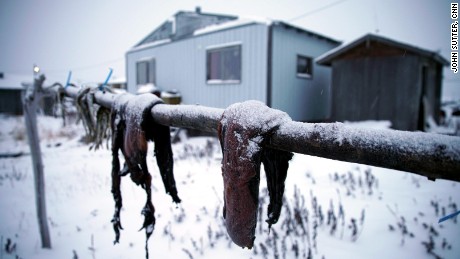
Local meats, including seal, hang from drying racks in the village. Seal oil, made from blubber, is a staple.
A few years after Norman’s death, Esau moved into Shelton and Clara Kokeok’s blue house at the edge of the Earth. Esau tells me he wanted to help his grandparents with chores his uncle might have performed, which would have included things like getting ice for drinking water from the lake, washing clothes in the local “Washateria” and emptying the “honey bucket” toilet.
Shelton remembers telling his grandson how much the village had changed over the years, how the weather wasn’t cold like it used to be, how these storms seemed bigger now, how much of the land, including the neighbor’s house, had already disappeared — and how he might be next.
“When I built this house, there was still more ground out there,” Shelton says. “We’re right on the edge of the beach now … Climate change is happening real fast.”
But none of this made sense to Esau — not really — until his senior year of high school.
That’s when he took Ken Stenek’s science class.
Stenek, an affable, big-smiling guy with a wiry beard and a kettlebell figure, told the students about the greenhouse effect — how pollution, mostly from fossil fuels, hangs around in the atmosphere and acts like a blanket, heating the planet. They watched “An Inconvenient Truth,” the high-profile documentary featuring former Vice President Al Gore and a graph often called the “hockey stick.” That now-famous chart shows that levels of carbon dioxide in the atmosphere haven’t been this high in hundreds of thousands of years.
Esau learned that a consensus of climate scientists — at least 97% — agree humans are causing rapid warming, and that continuing to pollute at current rates would be catastrophic, contributing to mass extinction, searing droughts, deadlier heat waves and more.
They also talked about the consequences for Shishmaref.
The “erosion” everyone in town was discussing?
That was related to the melting sea ice, the thawing of permafrost, the frequency of damaging storms. In short: By burning fossil fuels, people were helping destroy this village.
If you’d asked him the year before what he wanted to do with his professional life, Esau would have told you he wanted to be a petroleum engineer, like his brother. Good money, he’d say, unaware that extracting and burning fossil fuels like oil is contributing to the problem.
Now, however, Esau was learning the science.
He thought about his grandfather’s house.
His uncle’s death.
He believes that climate change had a hand in both.
‘Imminent’ threats
This education took him all the way to Paris.
Through Ken Stenek’s science class, Esau met researchers who were studying climate change and its consequences. And through those connections he became an Arctic Youth Ambassador, which is a program of two federal agencies and Alaska Geographic, a nonprofit. He learned that Shishmaref is not alone — that 31 villages in Alaska face “imminent” threats from erosion and other issues related to climate change, according to a Government Accountability Office report; and that 12 of them were exploring relocation options because of warming.
Esau started to wonder: Could Shishmaref actually survive the melting of the Arctic?
Was his village’s life nearing its end?
Or the start of a new beginning?
Those questions never occurred to Esau before, although they had been on the lips of older people in Shishmaref for years. They’re questions kept from young people, hoping to protect them, wanting them to grow up with a sense that the world is more certain than it is.
The Obama White House named Esau a Champion of Change for Climate Equity. He got to go to Washington. Then, he said, with help from the Sierra Club, an environmental group, he got to attend international climate change negotiations in Paris in December 2015. It was that meeting — which is often called “COP21,” since that’s simpler than “the 21st meeting of the conference of parties to the UN Framework Convention on Climate Change” — where world leaders agreed, after decades of failure, to work together to end the fossil fuel era.
The target: Limit global temperature increases to no more than 2 degrees Celsius.
Basically, that means eliminating fossil fuels this century.
In Paris, hope filled the air — hope for a cleaner, safer future.
Esau, meanwhile, arrived in the French capital terrified.
It was just so different from Shishmaref.
“It felt a little claustrophobic to me, being in a big city for the first time,” he says. “It felt like I just can’t take a walk or go outside and walk without thinking of being threatened or beat up. When you walk around here, you don’t feel that. Everyone here is family. You get a sense of trust.” He was so afraid of Paris — its clustered buildings, sidewalks thick with people, streets clogged with smoking cars — that he did not dare leave the hotel without an escort.
The scale of the place got to him in other ways, too.
How much pollution are all these people creating?
How do you get all of them to change?
In a word: overwhelming.
Yet amid this chaos, Esau made another leap of understanding.
‘Before it completely erodes away’

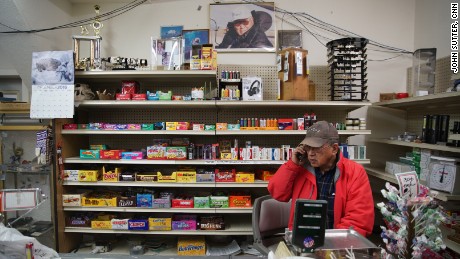
Percy Nayokpuk owns one of two stores in town. “Climate change is happening,” he says.
Rae Bainteiti comes from Kiribati, a tropical island nation that could not be more geographically dissimilar from Shishmaref. Sun and sand vs. ice and snow. The two places are thousands of miles apart, separated by the vast Pacific Ocean and a half-world of latitude, with Shishmaref near the Arctic Circle and Kiribati near the equator. Yet when an interviewer sat Rae down with Esau in Paris, the two young men discussed the perils of a common threat.
Both may have to relocate because of climate change.
“My future generation of kids will be the last ones that will actually be on the island of Shishmaref before it completely erodes away,” Esau tells Rae in the Paris interview,
which is posted on YouTube.He looks directly at the other young man.
“It’s just really sad knowing that you probably have to relocate and migrate, too,” Esau says.
“Your country has to be stopped from melting so we don’t see water rising,” Rae replies.
The two share a laugh at the irony of the situation: As Arctic ice melts and oceans warm, sea levels around the world are rising. A host of locations, from Pacific islands like Kiribati to low-lying countries like Bangladesh and cities from New York to Shanghai will be threatened with coastal flooding — and possibly relocation, too — as people continue to pump greenhouse gases into the atmosphere. Already,
Miami Beach, Florida, is installing pumps and raising street levels to try to hold the water back. That work is only the beginning of a $400-million-plus project. In 2016,
the community of Isle de Jean Charles, Louisiana, got a $48 million federal grant to relocate, in part because of rising seas. But this is the exception rather than the rule. Most local governments don’t have the money for infrastructure to hold rising tides back.
Experts say there are no programs — in the United States or internationally — designed specifically to plan and fund climate-driven relocations. Only a few moves have been funded with money designated for climate adaptation projects, said Elizabeth Ferris, research professor at Georgetown University’s Institute for the Study of International Migration.
“Governments are reluctant to think about planned relocations because everyone wants to stay where they are,” she told me. But “if it isn’t planned well, it just doesn’t work. It leaves people much worse off.”
“There’s no federal or state law — no institution in the United States — with a mandate for how are we going to manage relocation internally,” said Alice Thomas, the climate displacement program manager at Refugees International, a non-profit group. “It’s going to be enormously expensive. It’s going to be very vulnerable people … people who aren’t going to be able to cut their losses on their home when they can’t get flood insurance. Where will they go?”
In Shishmaref, the answer remains unclear.
Relocation


Local officials in Shishmaref discuss the possibility of climate relocation. They do not have the money to move.
August 2016.
Globally, it tied for the hottest month of the hottest year on record. In Shishmaref, residents went to the polls to decide whether they would relocate because of warming.
The answer: Yes, by a margin of 89 to 78, according to local officials.
But the August 16 vote did not solve Shishmaref’s trouble. Far from it.
Annie Weyiouanna, local coordinator for the Native Village of Shishmaref, tells me the tribe has no money to fund the move. And this isn’t the first time the village has held a relocation vote. They did so in 2002, as well. Nothing changed. No one in the village today is packing. And Weyiouanna has tried to stop using the word “relocation” — or uses it minimally, sometimes correcting herself — because she worries it will signal to funding agencies in the state and federal governments that the village will be gone soon and doesn’t need help with grants or infrastructure. The reality is that no one knows how long the village will be stuck.
Perhaps forever, some worry, or until the island is gone.
“They are not safe right now, and their lives are in danger because of the storms that are coming in,” said Robin Bronen, executive director of the Alaska Institute for Justice and a senior research scientist at the University of Alaska Fairbanks. She was referring to Shishmaref as well as Newtok and Kivalina, Alaska, which face similar circumstances. “(T)hey just need a large sum of money to get them to the places that they’ve chosen so they can be safe.”
Shishmaref has identified two potential sites for a new version of the community. Both are inland, meaning hunters and fishers would not be able to access the sea as easily. Some people in the community — particularly elders — believe the move threatens the tribe’s Inupiat identity.
Away from the coast, are they still the same people?
Why should they move when others are driving climate change?
Esau has wrestled with these questions, too. His grandparents, Shelton and Clara, the couple in the blue house at the edge of the Earth, who lost their son to the ice, do not want to leave. They want to stay in their home — in the community they know so well — no matter the risks.
Esau worries about them.
“If you ask the older generations like my grandfather, their views are totally different,” he tells me. “They want to stay on this island forever and ever. And I respect that decision. They’re my elders.
“But, to me, I think we have to relocate so that our future generations can still be alive.”
Norman, age 7

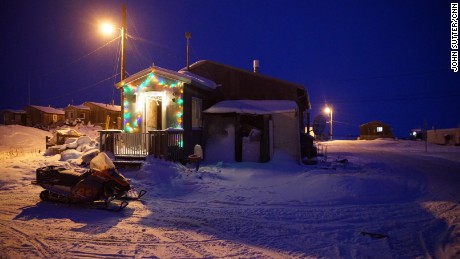
In the winter, the skies in Shishmaref appear to be frozen in twilight.
On my last day in Shishmaref, Esau and I paid his old science teacher a visit.
We found Ken Stenek in a cream-colored house with Christmas lights on the roofline. He lives on a part of the island where houses are newer. Some were moved from the side where Esau’s grandparents live, and where coastal erosion is more threatening.
Standing in his home, I couldn’t help but think about the cemetery.
About the two men — Esau and Norman — who are buried there.
Two young people, bearing those names, were standing in the room with me.
There was Esau Sinnok, standing in the entryway, of course.
But also Norman, sitting on the sofa in the living room.
Norman Stenek, age 7.
The boy was named after Esau’s uncle, the one who fell through the ice.
When I visited, young Norman seemed more interested in a tablet computer than a conversation with a random reporter, and I can’t blame him for that. Still, the encounter sticks with me.
It made me wonder: What will his life be like?
His name — Norman — carries a tragic legacy. The death in the plane crash. The fall through the ice. Will this 7-year-old live to see the rest of the village drown beneath the waves, too?
Will the same happen to millions of coastal residents during his lifetime?
And what about Esau?
Sometimes I think the weight of this tragedy falls on his young shoulders. His namesake was a local agitator and his uncle’s death drove him into activism. The strength of his voice — his power to command attention — has surprised a village where few care to stand out from the crowd. He speaks out against fossil fuels, saying that the world must rush to a future with 100% renewable, clean energy. It may be too late for Shishmaref, he says, but what about other communities in similar straits? How many people will pollution force from their homes?
“I don’t blame it on one person, or a group of people. It’s all our fault,” Esau tells me. “It’s not the 1940s anymore. We can’t use fossil fuels anymore to heat our homes and use for our energy.
“We can transition from dirty fossil fuels to renewable energies.”
But how much weight can a 19-year-old bear?
The rest of us must realize our role in this tragedy.
Responsibility for Shishmaref’s plight falls on those in the industrialized world who continue to pollute the atmosphere with carbon, knowing it will warm the climate, melt the ice and make it less likely Shishmaref will survive. It falls on the Trump administration,
which has moved to defund and upend climate change initiatives instead of planning for a transition to cleaner power sources, like wind and solar. It falls on politicians who know the scope of the impending climate relocation crisis but have done little to make adequate plans or secure appropriate funding.
Shishmaref is part of America, even if it’s rarely treated that way.
It is a place where people never really die, where the cemetery on that hilltop in the center of the island is full of people like Norman and Esau who are kept alive by names and stories. The question now is whether villages, like people, can be reincarnated.
Can Shishmaref be reborn?
Sadly, it’s a question the village cannot answer on its own.

